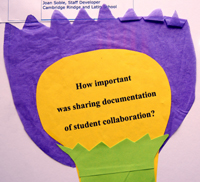On June 5, with eight class days left before the end of the school year, I got my students started on an analytical essay about Lord of the Flies by William Golding, the book they had spent the previous 3 1/2 weeks reading and thinking about. I chose to begin the week by showing a simple five-minute slideshow of pictures that I had taken over the previous month. I entitled the slideshow, "Working Together in World Lit. I." I added a few titles that emphasized different types of collaboration. When it was over, I told my students that I wanted to remind them of how well they had been working together because we were about to embark on our final piece of collaborative work.
Looking back, I was struck by how smoothly that Monday went - and the rest of the week, too. Then, on Friday, the day the paper was due, there was a higher rate of completion for this challenging assignment than any other major piece of work we had done all semester. I had to wonder if it had anything to do with that little slideshow.



